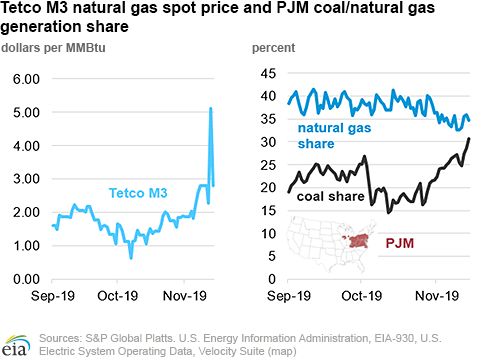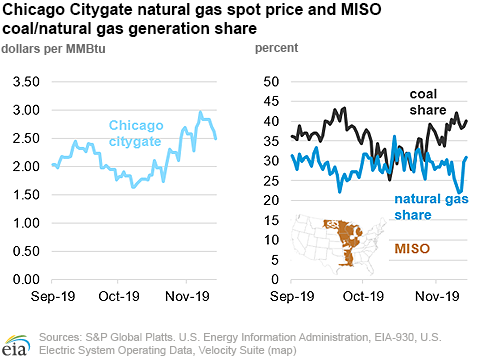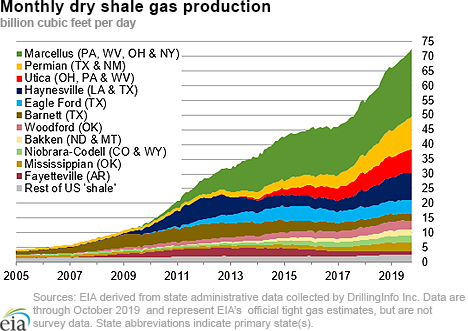In the News:
Natural gas-fired generation returns to pre-October levels in PJM and MISO
A November cold snap resulted in prices for natural gas rebounding from an average of less than $2.00 per million British thermal units (MMBtu) in October to mid-November highs of $5.11/MMBtu at the Tetco M3 hub, located in northeast Pennsylvania in the PJM Interconnection (PJM), and nearly $3.00/MMBtu at the Chicago Citygate hub in the Midcontinent Independent System Operator (MISO). These price increases caused coal-fired power generation to replace natural gas-fired generation starting in late October in both of these regional transmission organization markets. In both PJM and MISO, where there is strong competition between natural gas- and coal-fired generation, relative shifts in fuel prices can influence which type of power plant operates.
Throughout all of 2019, natural gas-fired generation has accounted for an increasing share of power generation in PJM and MISO, averaging 35% in PJM and 27% in MISO. This summer saw record natural gas consumed for generation across the Lower 48 states, supported by relatively low natural gas prices, retirement of coal-fired generation, and increasing natural gas-fired capacity. In October, when regional natural gas prices were particularly low, natural-gas fired generation in MISO reached its highest level for 2019 at 36%. However, as natural gas spot prices in the PJM and MISO regions approached about $2.70/MMBtu in late October, the coal-fired generation share rebounded from its earlier lows.
PJM
The PJM Interconnection spans states located in the Middle Atlantic. Cold weather in that region resulted in the natural gas spot price at the Tetco M3 trading hub to rise from less than $2.00/MMBtu at the end of October to as high as $5.11/MMBtu on November 13. On November 9, the share of natural gas-fired generation in PJM decreased to 34%, its lowest level since May 2019. Conversely, coal’s generation share increased to 31% on November 14, which is the highest coal share since March 2019.
MISO
MISO‘s region covers much of the Midwest and part of the Gulf Coast. For several days in October, the share of natural gas-fired generation was higher than the share of coal-fired generation in MISO, the first time in 2019. With low natural gas spot prices, natural gas-fired generation peaked at a 36% generation share on October 14. In contrast, coal’s generation share fell to 25% on October 12 because of low natural gas prices and strong wind generation. However, by November, lower wind power and higher natural gas prices made coal-fired generation more economically attractive. The Chicago Citygate natural gas spot price rose to nearly $3.00/MMBtu on November 7 after spending most of October lower than $2.00/MMBtu. The higher natural gas prices contributed to the natural gas generation share falling to 22% on November 10, its lowest share in eight months. Meanwhile, coal’s generation share increased from its October average of about 32% to a November average of 38% through November 13.
Overview:
(For the week ending Wednesday, November 20, 2019)
- Natural gas spot price movements were mixed this report week (Wednesday, November 13, to Wednesday, November 20). The Henry Hub spot price fell from $2.62 per million British thermal units (MMBtu) last Wednesday to $2.47/MMBtu yesterday.
- At the New York Mercantile Exchange (Nymex), the price of the December 2019 contract decreased 4¢, from $2.600/MMBtu last Wednesday to $2.559/MMBtu yesterday. The price of the 12-month strip averaging December 2019 through November 2020 futures contracts declined 6¢/MMBtu to $2.427/MMBtu.
- The net withdrawal from working gas totaled 94 billion cubic feet (Bcf) for the week ending November 15. Working natural gas stocks total 3,638 Bcf, which is 16% more than the year-ago level and 2% lower than the five-year (2014–18) average for this week.
- The natural gas plant liquids composite price at Mont Belvieu, Texas, rose by 9¢/MMBtu, averaging $5.78/MMBtu for the week ending November 20. The price of isobutane fell by 2%. The prices of ethane, natural gasoline, and propane rose by 1%, 2%, and 4%, respectively. The price of butane remained flat week over week.
- According to Baker Hughes, for the week ending Tuesday, November 12, the natural gas rig count decreased by 1 to 129. The number of oil-directed rigs fell by 10 to 674. The total rig count decreased by 11, and it now stands at 806.
Prices/Supply/Demand:
Prices at major hubs decline as record-cold temperatures subside. This report week (Wednesday, November 13, to Wednesday, November 20), the Henry Hub spot price fell 15¢ from $2.62/MMBtu last Wednesday to a low of $2.47/MMBtu yesterday. Temperatures were generally cooler than normal east of the Rocky Mountains and warmer than normal across the rest of the country following record cold November temperatures on November 13. At the Chicago Citygate, the price decreased 5¢ from $2.49/MMBtu last Wednesday to $2.44/MMBtu yesterday.
California prices are up as temperatures begin to cool. The price at SoCal Citygate in Southern California increased $1.66 from $4.27/MMBtu last Wednesday to a high of $5.93/MMBtu yesterday. While the Los Angeles area experienced above-average temperatures over the weekend, seasonably cooler temperatures returned yesterday, reaching a minimum of 52 degrees Fahrenheit (°F). The price at PG&E Citygate in Northern California rose 24¢, up from $3.08/MMBtu last Wednesday to $3.32/MMBtu yesterday.
Northeast prices are down in population centers, nearly flat at supply hubs. At the Transcontinental Pipeline Zone 6 trading point for New York City, the price decreased 84¢ from a high of $3.27/MMBtu last Wednesday to a low of $2.43/MMBtu yesterday as temperatures warmed. At the Algonquin Citygate, which serves Boston-area consumers, the price went down 35¢ from $3.93/MMBtu last Wednesday to $3.58/MMBtu yesterday. Prices were largely unaffected after the Algonquin Gas Transmission announced planned maintenance for November 21. The event will reduce flows by an estimated 23% at its Stony Point compressor station, 50 miles north of New York City.
The Tennessee Zone 4 Marcellus spot price increased 2¢ from $2.05/MMBtu last Wednesday to $2.07/MMBtu yesterday. The price at Dominion South in southwest Pennsylvania rose 1¢ from $2.14/MMBtu last Wednesday to $2.15/MMBtu yesterday.
Permian Basin discount to the Henry Hub widens throughout the week. The price at the Waha Hub in West Texas, which is located near Permian Basin production activities, averaged a high of $1.84/MMBtu last Wednesday, 78¢/MMBtu lower than the Henry Hub price. Yesterday, the price at the Waha Hub averaged $0.94/MMBtu, $1.53/MMBtu lower than the Henry Hub price. Permian region prices were initially increased with the completion of the Gulf Coast Express at the end of August, which added 2 Bcf/d of takeaway capacity. However, natural gas production in the region has increased, occupying the new available capacity and resulting in ongoing constraints that placed downward pressure on prices.
Supply is flat despite increases in production. According to data from IHS Markit, the average total supply of natural gas remained the same as in the previous report week, averaging 100.2 Bcf/d. Dry natural gas production grew by 1% compared with the previous report week. Average net imports from Canada decreased by 17% from last week.
Demand is down across all sectors, led by declines in power burn. Total U.S. consumption of natural gas fell by 5% compared with the previous report week, according to data from IHS Markit. Natural gas consumed for power generation declined by 7% week over week. Industrial sector consumption decreased by 1% week over week. In the residential and commercial sectors, consumption declined by 5%. Natural gas exports to Mexico were the same as last week, averaging 5.3 Bcf/d.
U.S. LNG exports decrease week over week. Twelve liquefied natural gas (LNG) vessels (six from Sabine Pass, three from Corpus Christi, two from Cove Point, and one from Cameron) with a combined LNG-carrying capacity of 43 Bcf departed the United States between November 14 and November 20, according to shipping data compiled by Bloomberg.
Freeport LNG, the developer of the three-train LNG-export facility 60 miles south of Houston on Quintana Island, Texas, filed a letter with the Federal Energy Regulatory Commission (FERC) requesting permission to place Train 1 in service. Train 1 (capacity 0.7 Bcf/d) exported its first LNG cargo in September and exported a total of seven cargoes to date. Freeport Train 2 is undergoing commissioning and is expected to begin LNG production in January 2020, followed by Train 3 in May 2020.
Storage:
The net withdrawal from storage totaled 94 Bcf for the week ending November 15, compared with the five-year (2014–18) average net withdrawal of 32 Bcf and last year's net withdrawal of 109 Bcf during the same week. Working natural gas stocks totaled 3,638 Bcf, which is 60 Bcf lower than the five-year average and 506 Bcf more than last year at this time.
According to The Desk survey of natural gas analysts, estimates of the weekly net change to working natural gas stocks ranged from a net withdrawal of 77 Bcf to 101 Bcf, with a median estimate of 89 Bcf./p>
More storage data and analysis can be found on the Natural Gas Storage Dashboard and the Weekly Natural Gas Storage Report.
See also:
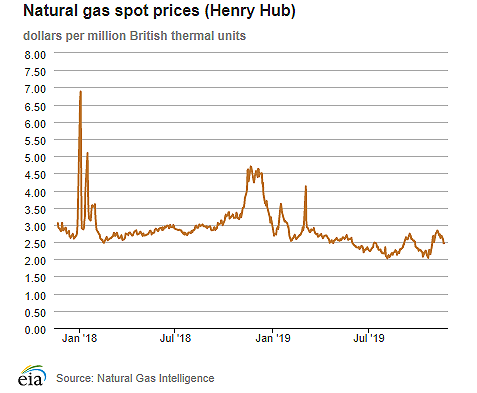
| Spot Prices ($/MMBtu) | Thu, 14-Nov |
Fri, 15-Nov |
Mon, 18-Nov |
Tue, 19-Nov |
Wed, 20-Nov |
|---|---|---|---|---|---|
| Henry Hub |
2.67 |
2.69 |
2.58 |
2.47 |
2.47 |
| New York |
2.85 |
2.90 |
2.66 |
2.59 |
2.43 |
| Chicago |
2.53 |
2.52 |
2.45 |
2.43 |
2.44 |
| Cal. Comp. Avg.* |
2.65 |
2.59 |
2.70 |
2.74 |
3.16 |
| Futures ($/MMBtu) | |||||
| December contract | 2.647 |
2.688 |
2.566 |
2.510 |
2.559 |
| January contract |
2.719 |
2.750 |
2.630 |
2.576 |
2.611 |
| *Avg. of NGI's reported prices for: Malin, PG&E Citygate, and Southern California Border Avg. | |||||
| Source: NGI's Daily Gas Price Index | |||||
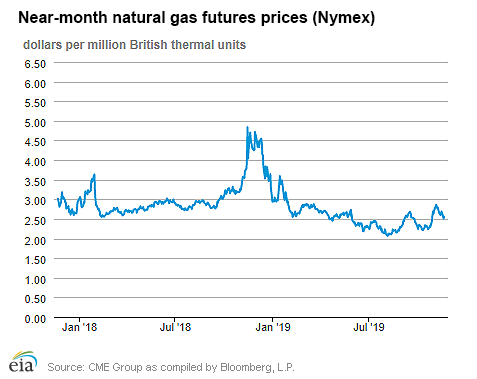
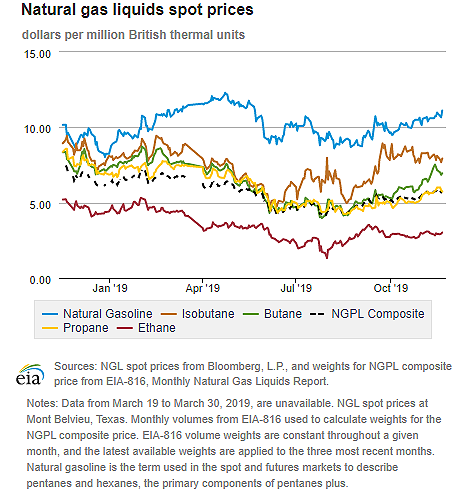
| U.S. natural gas supply - Gas Week: (11/14/19 - 11/20/19) | |||
|---|---|---|---|
Average daily values (Bcf/d): |
|||
this week |
last week |
last year |
|
| Marketed production | 108.4 |
107.6 |
97.5 |
| Dry production | 95.6 |
95.0 |
87.1 |
| Net Canada imports | 4.4 |
5.3 |
4.2 |
| LNG pipeline deliveries | 0.1 |
0.2 |
0.1 |
| Total supply | 100.2 |
100.6 |
91.4 |
|
Source: IHS Markit | |||
| U.S. natural gas consumption - Gas Week: (11/14/19 - 11/20/19) | |||
|---|---|---|---|
Average daily values (Bcf/d): |
|||
this week |
last week |
last year |
|
| U.S. consumption | 84.7 |
88.7 |
89.0 |
| Power | 26.1 |
27.9 |
28.1 |
| Industrial | 22.1 |
22.3 |
24.6 |
| Residential/commercial | 36.5 |
38.6 |
36.2 |
| Mexico exports | 5.3 |
5.3 |
4.6 |
| Pipeline fuel use/losses | 7.0 |
7.1 |
6.8 |
| LNG pipeline receipts | 7.2 |
7.1 |
4.4 |
| Total demand | 104.2 |
108.2 |
104.8 |
|
Source: IHS Markit | |||
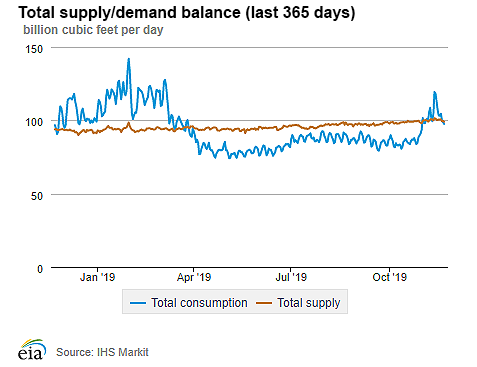
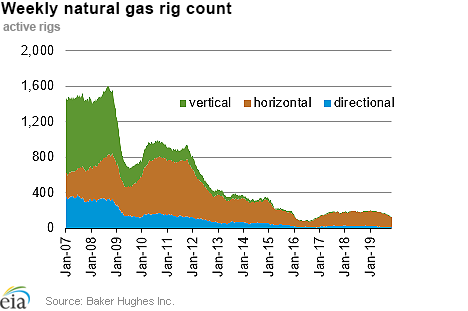
| Rigs | |||
|---|---|---|---|
Tue, November 12, 2019 |
Change from |
||
last week |
last year |
||
| Oil rigs | 674 |
-1.5% |
-24.1% |
| Natural gas rigs | 129 |
-0.8% |
-33.5% |
| Note: Excludes any miscellaneous rigs | |||
| Rig numbers by type | |||
|---|---|---|---|
Tue, November 12, 2019 |
Change from |
||
last week |
last year |
||
| Vertical | 0 |
0.0% |
0.0% |
| Horizontal | 14 |
16.7% |
-51.7% |
| Directional | 54 |
-3.6% |
-23.9% |
| Source: Baker Hughes Inc. | |||
| Working gas in underground storage | ||||
|---|---|---|---|---|
Stocks billion cubic feet (Bcf) |
||||
| Region | 2019-11-15 |
2019-11-08 |
change |
|
| East | 909 |
932 |
-23 |
|
| Midwest | 1,069 |
1,106 |
-37 |
|
| Mountain | 205 |
207 |
-2 |
|
| Pacific | 292 |
290 |
2 |
|
| South Central | 1,164 |
1,197 |
-33 |
|
| Total | 3,638 |
3,732 |
-94 |
|
|
Source: Form EIA-912, Weekly Underground Natural Gas Storage Report | ||||
| Working gas in underground storage | |||||
|---|---|---|---|---|---|
Historical comparisons |
|||||
Year ago (11/15/18) |
5-year average (2014-2018) |
||||
| Region | Stocks (Bcf) |
% change |
Stocks (Bcf) |
% change |
|
| East | 808 |
12.5 |
893 |
1.8 |
|
| Midwest | 964 |
10.9 |
1,076 |
-0.7 |
|
| Mountain | 175 |
17.1 |
210 |
-2.4 |
|
| Pacific | 259 |
12.7 |
326 |
-10.4 |
|
| South Central | 927 |
25.6 |
1,193 |
-2.4 |
|
| Total | 3,132 |
16.2 |
3,698 |
-1.6 |
|
| Source: Form EIA-912, Weekly Underground Natural Gas Storage Report | |||||
| Temperature – heating & cooling degree days (week ending Nov 14) | ||||||||
|---|---|---|---|---|---|---|---|---|
HDD deviation from: |
CDD deviation from: |
|||||||
| Region | HDD Current |
normal |
last year |
CDD Current |
normal |
last year |
||
| New England | 220 |
67 |
41 |
0 |
0 |
0 |
||
| Middle Atlantic | 211 |
67 |
29 |
0 |
0 |
0 |
||
| E N Central | 261 |
97 |
20 |
0 |
0 |
0 |
||
| W N Central | 262 |
81 |
-17 |
0 |
0 |
0 |
||
| South Atlantic | 148 |
54 |
25 |
13 |
-1 |
-11 |
||
| E S Central | 173 |
77 |
21 |
0 |
-2 |
0 |
||
| W S Central | 128 |
65 |
-3 |
1 |
-7 |
-1 |
||
| Mountain | 135 |
-27 |
-62 |
6 |
5 |
5 |
||
| Pacific | 33 |
-46 |
-35 |
0 |
-1 |
0 |
||
| United States | 175 |
48 |
1 |
3 |
-1 |
-2 |
||
|
Note: HDD = heating degree day; CDD = cooling degree day Source: National Oceanic and Atmospheric Administration | ||||||||
Average temperature (°F)
7-day mean ending Nov 14, 2019
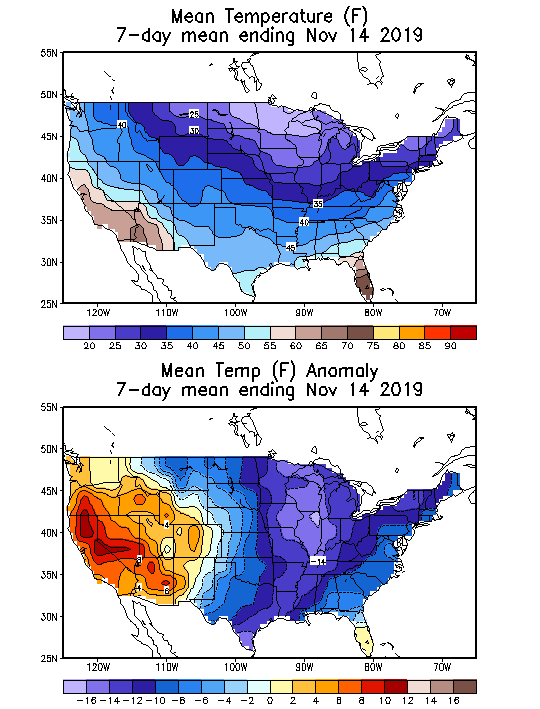
Source: National Oceanic and Atmospheric Administration
Deviation between average and normal (°F)
7-day mean ending Nov 14, 2019

Source: National Oceanic and Atmospheric Administration

